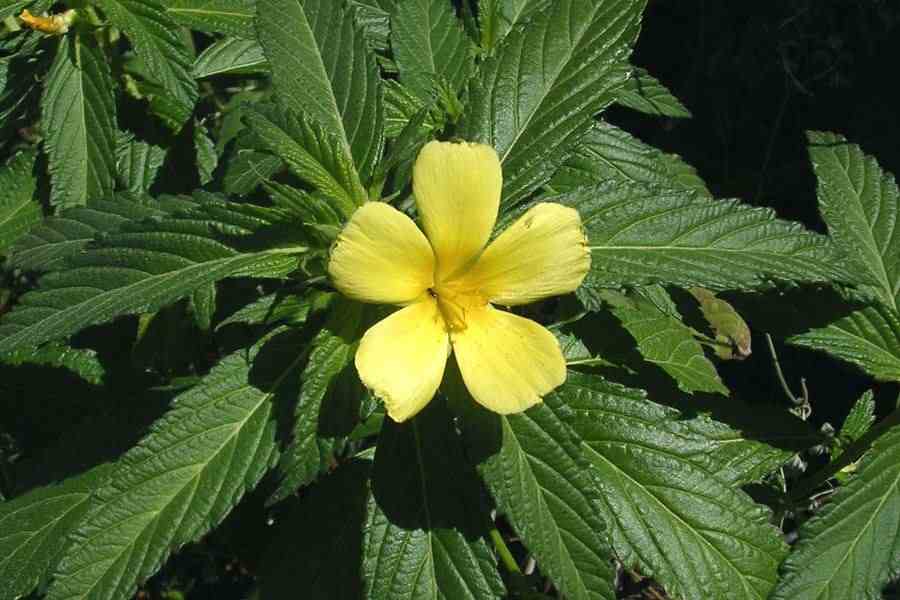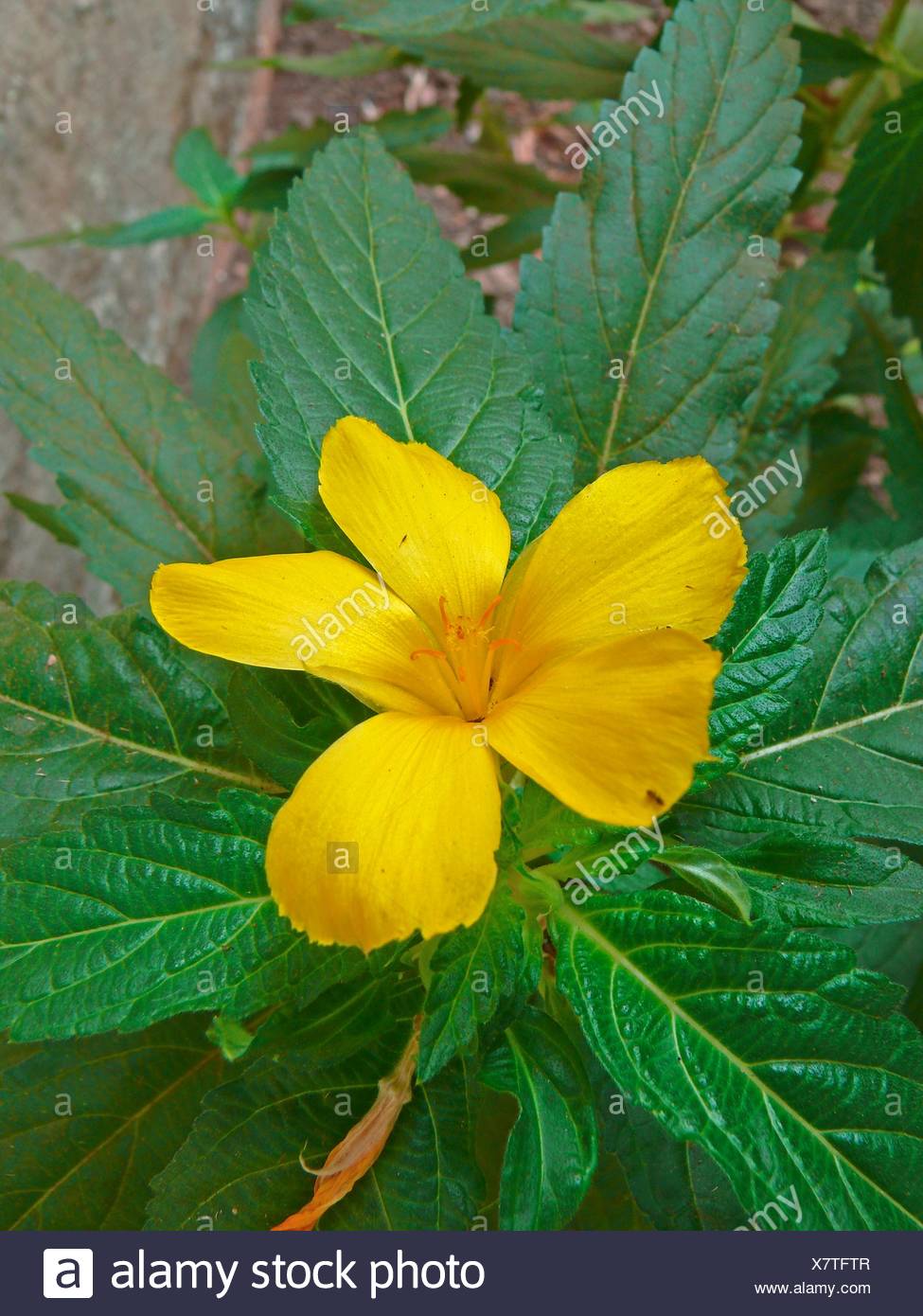This is the first season I’ve grown white Cuban buttercup, Turnera trioniflora. I planted it in a large container on my back deck as the spiller portion of the thriller, filler, and spiller planting technique.
Yellow Buttercup Bush - Sage Rose - Large single yellow blooms on very lush dark green foliage growing 6-12 tall preferring a sunny location. It loves heat and humidity and hardy in zones 9-11. Large single white blooms on very lush dark green foliage growing 6-12' tall perfering a sunny location. It loves heat and humidity and hardy in zones 9-11. Very showy white buttercup flowers with a violet almost black center and a halo of yellow.
Flowers that open and close
I love how white Cuban buttercup opens early in the morning as soon as the sun hits it. It closes up shop around Noon or so. Of course, if we have a cloudy day, it stays open longer. Flowers that only open for part of the day add a little mystery to things, and I find I look for their presence in the garden more.Mirabilis jalapa, four o’clocks, Portulaca grandiflora, rose moss, Ipomoea alba, moonflower, and Ipomoea purpurea, morning glories, are other flowers that quickly come to mind with specific opening and closing times. I wrote about morning glories in ten more easy flowers to grow in Oklahoma. Four o’clocks were featured in summer flowers for summer heat.
A tropical temptation
White Cuban buttercup, Turnera trioniflora, is tropical and won’t overwinter in Oklahoma’s Zone 6a through 8b climate. I’m sure you could take cuttings, and it may form seed, but, if so, I haven’t seen it so far this year. Mine is a trailing variety that looks great at the front of a pot or a flowerbed.
Sometimes, simple flowers are better
White Cuban buttercup is a simple flower to grow. I bought mine at Bustani Plant Farm. Remember, tropical plants are a summer garden’s best friend.
My monthly newsletter
Turnera Buttercup
I’m now writing a monthly newsletter. It may be about gardening or garden travel. You can subscribe to either one or both in the sidebar, or when you read the newsletter. This month was about butterfly ranching season. I hope you like it.
Don’t forget our garden podcast
If you’re up for a garden podcast episode, Carol Michel and I have a new one at the Gardenangelists. This week, we’re discussing helping a garden age gracefully. If you like our podcasts, please hit that subscribe button where you listen. Thanks!

Introduction
Yellow alder is a small shrub native to the Caribbean basin (Fig. 1). Many stems originate close to the ground but they branch infrequently forming an open, leggy plant. Those in the full sun branch more and stay fuller than those in partial shade. Clear yellow flowers are produced daily, each lasting several hours before closing at night. New flowers open the next morning. Leaves stay dark green with little or no fertilizer.
Figure 1.Yellow alder
[Click thumbnail to enlarge.]
General Information
Scientific name: Turnera ulmifolia
Pronunciation: TERN-er-uh ul-miff-FOLE-lee-uh
Common name(s): yellow alder, yellow elder
Family: Turneraceae
Plant type: ground cover
USDA hardiness zones: 9 through 11 (Fig. 2)
Planting month for zone 9: year round
Planting month for zone 10 and 11: year round
Origin: not native to North America
Uses: foundation; border; mass planting; ground cover; attracts butterflies
Availability: generally available in many areas within its hardiness rangeFigure 2.
Shaded area represents potential planting range.

[Click thumbnail to enlarge.]
Description
Height: 2 to 3 feet
Turnera Buttercup Bushes
Spread: 2 to 3 feet
Plant habit: round
Plant density: moderate
Growth rate: moderate
Texture: medium

Foliage
Leaf arrangement: opposite/subopposite
Leaf type: simple
Leaf margin: serrate
Leaf shape: ovate
Leaf venation: pinnate
Leaf type and persistence: evergreen
Leaf blade length: 2 to 4 inches
Leaf color: green
Fall color: no fall color change
Fall characteristic: not showy
Flower
Flower color: yellow
Flower characteristic: year-round flowering
Fruit
Fruit shape: unknown
Fruit length: unknown
Fruit cover: unknown
Fruit color: unknown
Fruit characteristic: inconspicuous and not showy
Trunk and Branches
Trunk/bark/branches: not particularly showy; typically multi-trunked or clumping stems
Current year stem/twig color: green
Current year stem/twig thickness: medium
Culture
Light requirement: plant grows in part shade/part sun
Soil tolerances: acidic; alkaline; sand; loam; clay
Drought tolerance: moderate
Soil salt tolerances: unknown
Plant spacing: 36 to 60 inches
Other
Roots: usually not a problem
Winter interest: plant has winter interest due to unusual form, nice persistent fruits, showy winter trunk, or winter flowers
Outstanding plant: not particularly outstanding
Invasive potential: may self-seed each year
Pest resistance: very sensitive to one or more pests or diseases which can affect plant health or aesthetics
Use and Management
Space plants several feet apart to form a ground cover in one season. To thicken the plant, cut stems back when they become leggy to force new branches close to the ground. To use as a low maintenance plant, consider locating alder alone as an accent in a shrub border or in a ground cover to display its natural open habit. It will display its bright yellow flowers on the outside edge of the plant without pruning. Alder seedlings often germinate near the plants and can become weeds in the landscape.
Plant yellow alder in the full sun or partial shade for best form and flowering. Plants appear to adapt to a variety of soil conditions including alkaline pH and dry sites. Freezing temperatures kill plants to the ground, but warm spring weather brings them back to life in central and south Florida.
Pests and Diseases
White flies are often found on the foliage. Severe infestations can injure the plants. Aphids and scales can also infest the foliage, but they are usually not too serious.
Footnotes

1.
This document is FPS-593, one of a series of the Environmental Horticulture Department, UF/IFAS Extension. Original publication date October 1999. Reviewed February 2014. Visit the EDIS website at http://edis.ifas.ufl.edu.
2.
Edward F. Gilman, professor, Environmental Horticulture Department, UF/IFAS Extension, Gainesville, FL 32611.
The Institute of Food and Agricultural Sciences (IFAS) is an Equal Opportunity Institution authorized to provide research, educational information and other services only to individuals and institutions that function with non-discrimination with respect to race, creed, color, religion, age, disability, sex, sexual orientation, marital status, national origin, political opinions or affiliations. For more information on obtaining other UF/IFAS Extension publications, contact your county's UF/IFAS Extension office.
U.S. Department of Agriculture, UF/IFAS Extension Service, University of Florida, IFAS, Florida A & M University Cooperative Extension Program, and Boards of County Commissioners Cooperating. Nick T. Place, dean for UF/IFAS Extension.
